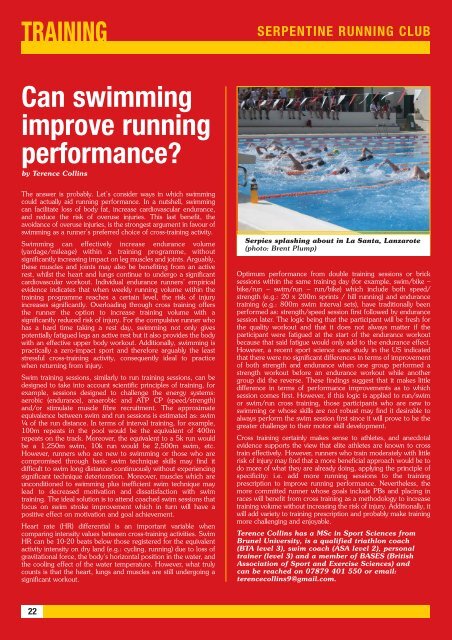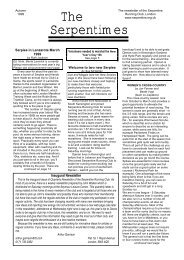AUTUMN 2007 - Serpentine
AUTUMN 2007 - Serpentine
AUTUMN 2007 - Serpentine
Create successful ePaper yourself
Turn your PDF publications into a flip-book with our unique Google optimized e-Paper software.
TRAINING<br />
SERPENTINE RUNNING CLUB<br />
Can swimming<br />
improve running<br />
performance?<br />
by Terence Collins<br />
The answer is probably. Let’s consider ways in which swimming<br />
could actually aid running performance. In a nutshell, swimming<br />
can facilitate loss of body fat, increase cardiovascular endurance,<br />
and reduce the risk of overuse injuries. This last benefit, the<br />
avoidance of overuse injuries, is the strongest argument in favour of<br />
swimming as a runner’s preferred choice of cross-training activity.<br />
Swimming can effectively increase endurance volume<br />
(yardage/mileage) within a training programme, without<br />
significantly increasing impact on leg muscles and joints. Arguably,<br />
these muscles and joints may also be benefiting from an active<br />
rest, whilst the heart and lungs continue to undergo a significant<br />
cardiovascular workout. Individual endurance runners’ empirical<br />
evidence indicates that when weekly running volume within the<br />
training programme reaches a certain level, the risk of injury<br />
increases significantly. Overloading through cross training offers<br />
the runner the option to increase training volume with a<br />
significantly reduced risk of injury. For the compulsive runner who<br />
has a hard time taking a rest day, swimming not only gives<br />
potentially fatigued legs an active rest but it also provides the body<br />
with an effective upper body workout. Additionally, swimming is<br />
practically a zero-impact sport and therefore arguably the least<br />
stressful cross-training activity, consequently ideal to practice<br />
when returning from injury.<br />
Swim training sessions, similarly to run training sessions, can be<br />
designed to take into account scientific principles of training, for<br />
example, sessions designed to challenge the energy systems:<br />
aerobic (endurance), anaerobic and ATP CP (speed/strength)<br />
and/or stimulate muscle fibre recruitment. The approximate<br />
equivalence between swim and run sessions is estimated as: swim<br />
¼ of the run distance. In terms of interval training, for example,<br />
100m repeats in the pool would be the equivalent of 400m<br />
repeats on the track. Moreover, the equivalent to a 5k run would<br />
be a 1,250m swim, 10k run would be 2,500m swim, etc.<br />
However, runners who are new to swimming or those who are<br />
compromised through basic swim technique skills may find it<br />
difficult to swim long distances continuously without experiencing<br />
significant technique deterioration. Moreover, muscles which are<br />
unconditioned to swimming plus inefficient swim technique may<br />
lead to decreased motivation and dissatisfaction with swim<br />
training. The ideal solution is to attend coached swim sessions that<br />
focus on swim stroke improvement which in turn will have a<br />
positive effect on motivation and goal achievement.<br />
Heart rate (HR) differential is an important variable when<br />
comparing intensity values between cross-training activities. Swim<br />
HR can be 10-20 beats below those registered for the equivalent<br />
activity intensity on dry land (e.g.: cycling, running) due to loss of<br />
gravitational force, the body’s horizontal position in the water, and<br />
the cooling effect of the water temperature. However, what truly<br />
counts is that the heart, lungs and muscles are still undergoing a<br />
significant workout.<br />
Serpies splashing about in La Santa, Lanzarote<br />
(photo: Brent Plump)<br />
Optimum performance from double training sessions or brick<br />
sessions within the same training day (for example, swim/bike –<br />
bike/run – swim/run – run/bike) which include both speed/<br />
strength (e.g.: 20 x 200m sprints / hill running) and endurance<br />
training (e.g.: 800m swim interval sets), have traditionally been<br />
performed as: strength/speed session first followed by endurance<br />
session later. The logic being that the participant will be fresh for<br />
the quality workout and that it does not always matter if the<br />
participant were fatigued at the start of the endurance workout<br />
because that said fatigue would only add to the endurance effect.<br />
However, a recent sport science case study in the US indicated<br />
that there were no significant differences in terms of improvement<br />
of both strength and endurance when one group performed a<br />
strength workout before an endurance workout while another<br />
group did the reverse. These findings suggest that it makes little<br />
difference in terms of performance improvements as to which<br />
session comes first. However, if this logic is applied to run/swim<br />
or swim/run cross training, those participants who are new to<br />
swimming or whose skills are not robust may find it desirable to<br />
always perform the swim session first since it will prove to be the<br />
greater challenge to their motor skill development.<br />
Cross training certainly makes sense to athletes, and anecdotal<br />
evidence supports the view that elite athletes are known to cross<br />
train effectively. However, runners who train moderately with little<br />
risk of injury may find that a more beneficial approach would be to<br />
do more of what they are already doing, applying the principle of<br />
specificity: i.e. add more running sessions to the training<br />
prescription to improve running performance. Nevertheless, the<br />
more committed runner whose goals include PBs and placing in<br />
races will benefit from cross training as a methodology to increase<br />
training volume without increasing the risk of injury. Additionally, it<br />
will add variety to training prescription and probably make training<br />
more challenging and enjoyable.<br />
Terence Collins has a MSc in Sport Sciences from<br />
Brunel University, is a qualified triathlon coach<br />
(BTA level 3), swim coach (ASA level 2), personal<br />
trainer (level 3) and a member of BASES (British<br />
Association of Sport and Exercise Sciences) and<br />
can be reached on 07879 401 550 or email:<br />
terencecollins9@gmail.com.<br />
22




